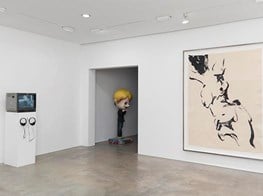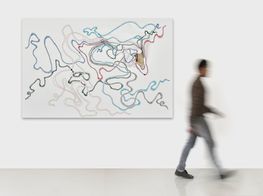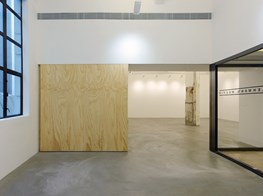Nicholas Hlobo at Lehmann Maupin, Seoul
South African artist Nicholas Hlobo's signature materials of rubber, ribbon, leather, and wood were all present in his first solo exhibition in Korea, held between 21 March and 18 May 2019 in Seoul. It comprised new and recent paintings along with a sculpture of copper piping titled Dyumpu (2019), each piece reflecting the artist's long-standing explorations of gender, sexual identity, and ethnicity.
In this video, Lehmann Maupin Seoul senior director Emma Son discusses Dyumpu (2019), along with Uzuko lwengcwele uIgnatiu (2019). All of the artist's works are titled in the Xhosa language—an assertion of his cultural identity that challenges the ascribed reading of his work as generically 'South African'. Dyumpu, which translates to 'splash', is an example of the metaphorical prowess at play in his work. From a spiralling mass of copper tubes, two leg-like pipes push upwards, ending with what resemble feet. The mass of copper takes hold of the space around it, its shape calling to mind the image of a figure falling backwards into a body of water and bringing to life the associative potential of its title.
Uzuko lwengcwele uIgnatiu translates to 'glory of Saint Ignatius', and as Son explains, was inspired by the 17th-century Baroque fresco in Rome at the Andrea Pozzo's Church of Saint Ignatius. Hlobo's rendition is abstract, with leather and ribbon stitched into the white canvas in organic shapes—a visual interplay between materials that are traditionally viewed as having masculine properties, in the case of leather, and feminine, in the case of the ribbon. The flowing lines that make up this work are similar to those of the copper tubes in Dyumpu, reflecting the artist's interest in ideas related to the continuous flow of life.
Born in Cape Town in 1975, Hlobo received a Bachelor of Technology from Technikon Witwatersrand in 2002, less than a decade after the end of apartheid in 1994. Much of the artist's material-focused practice deals with this history through the act of cutting and piecing together to create a hybrid, anthropomorphic whole, rooted in an articulation of Xhosa's rich culture. In Ingubo Yesizwe (2008), for instance, which translates to 'clothes or blanket of the nation', pieces of rubber, gauze, ribbon, and leather are stitched together to resemble a headless beast that appears to be heaving forward. The title relates to a commemorative practice in Xhosa culture in which the hide of a cow slaughtered in ritual is used to cover a corpse before burial, protecting the individual in his or her passage to the afterlife.
Hlobo's work often triggers a consideration of the multifaceted nature of identity, and in particular prompts ideas around sexual orientation, and the prejudice against homosexuality in Black society. Bodily forms and visual references to items such as condoms proliferate his practice, with the phallic present throughout many of his works. 'I come from a culture where the penis is very important', explains the artist. An earlier work Mphephethe uthe cwaka (2017), the twhich translates to 'Blowing them in silence', refers to oral sex, but also the power of music and sound. Like Dyumpu (2019) at Lehmann Maupin, the work comprises copper tubing, but this time the tubing's appendages are in the form of trumpet horns.
Hlobo's artwork has been the subject of solo exhibitions at institutions such as The Hague, Netherlands (2016); Savannah College of Art and Design, Lacoste, France (2010); Tate Modern, London (2008); Institute of Contemporary Art, Boston (2008); and SCAD Museum of Art, GA (2007). Hlobo has participated in multiple institutional exhibition, including the 18th Biennale of Sydney, Australia (2012); the 54th Venice Biennale (2011); the 6th Liverpool Biennial (2010); and the 3rd Guangzhou Triennial, China (2008). His work is included in numerous international public and private collections, including The Metropolitan Museum of Art, New York; the Fondation Louis Vuitton, Paris; South African National Art Gallery, Cape Town; and the Tate Modern, London. Hlobo has received numerous honours and distinctions such as the Rolex Visual Arts Protégé (2010–2011); Standard Bank Young Artist Award (2009); and the Tollman Award for Visual Art (2006).—[O]










































































































































































